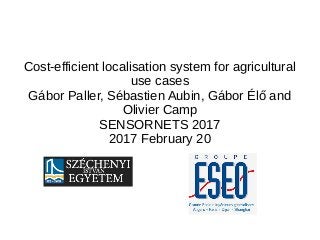
Cost-efficient localisation system for agricultural use cases
- 1. Cost-efficient localisation system for agricultural use cases Gábor Paller, Sébastien Aubin, Gábor Élő and Olivier Camp SENSORNETS 2017 2017 February 20
- 2. Localisation in agriculture ● For high-value machinery High-end GPS receiver price: up to 10000 USD (also, usually purchase is restricted)
- 3. What about the lower-value stock? We need about 1m precision with low-cost receivers!
- 4. Participating projects ● Széchenyi University, Győr: AgroDat project (AGRODAT VKSZ_12-1-2013-0024), localization of agricultural robots, financed by the government of Hungary ● ESEO, Angers: Vagabond project, localization and health of livestock (cows), financed by “Pays de la Loire” region
- 5. Low-cost GPS receiver study ● With differential (SBAS) support ● With a high-precision geodetic GPS as reference
- 6. Typical measurement • Origo: location with known, precise coordinates (geodetic reference point) where all the devices were placed. • Color code: • Red: geodesic GPS receiver (Ashtech Z-Xtreme) • Blue, green, cyan: MT3339 (three receivers, same location, locked to SBAS) • Magenta: Samsung Galaxy S4 mini smartphone • Conclusion: standalone low-cost receivers will not satisfy the precision requirements!
- 7. Low-cost differential GPS Herrera, A. M., Suhandri, H. F., Realini, E., Reguzzoni, M., and Lacy, M. C. (2016). goGPS: Open-source MAT-LAB software. GPS Solut., 20(3):595–603. NMEA data (not used) Corrected positions Raw data (pseudorange, carrier phase) NMEA data (not used) Raw data (pseudorange, carrier phase, ephemeris) or Fixed station Rover station Raw data (e.g. RINEX) Low-cost GPS receiver (raw data) Professional reference station Low-cost GPS receiver (fixed) goGPS software
- 8. Low-cost GPS receiver U-blox LEA-6T, directly supported by goGPS
- 9. Position noise Precision after low-pass filtering of goGPS corrected positions with different GPS receiver sampling frequency
- 10. Need for short-range localization ● GoGPS is not suitable for localizing moving objects due to long filtering period ● However, it is quite precise when localizing objects that are stationary for >10 minutes ● For robots, these stationary objects can be positioning poles ● For cows, these stationary objects can be other cows if they stay in the same place long enough
- 12. Time-of-arrival (TOA) localization • Radio trilateration (Time-of-arrival, UWB) r1 r2 r3 Fix points with known position Point with unknown position
- 13. Effect of reference point positioning error ● 1000 iterations ● Color “rectangles”: 10 fix points plus added errors ● Color “patch” around -50,60: calculated positions
- 14. Distance error vs. fix point error ● Simulation to find out whether measured distance error vs. fix point localization error has more effect – 10 fixed points – 1000 iterations ● Error added to distance measurements: – maximum x,y error: 9.7, 9.9 meters respectively – mean of the error: 2.9 meters ● Error added to fixed point measurements – maximum x,y error: 9.4, 10 meters respectively – Mean of the error: 0.2 meters ● It is better to have error on the fixed point positions than on the distance measurements
- 15. Angle-of-arrival (AOA) localization Point with known position Point with unknown position α1 α2 α3 Directional antenna
- 16. Effect of angle measurement error
- 17. Conclusions ● Standalone receivers have problems satisfying the less than 1m precision requirement (even expensive ones) ● With differential setup, low-cost GPS receivers can produce the required precision for stationary targets ● GoGPS is able to locate targets with 1m precision using low-cost receivers if the target stays in place for at least 10 minutes ● At least some cows move infrequently enough so that they can act as quasi- stationary reference points ● For moving targets, short-range positioning methods are proposed – Distance-measurement (UWB) works well if there are enough many reference points (>4) and the reference points are separated well. Also, if the same error is introduced into the fixed points positions vs. the distance measurement, error in fixed point positions gives better results. – Angle-measurement works well if the target to locate is not far away (<50m).
